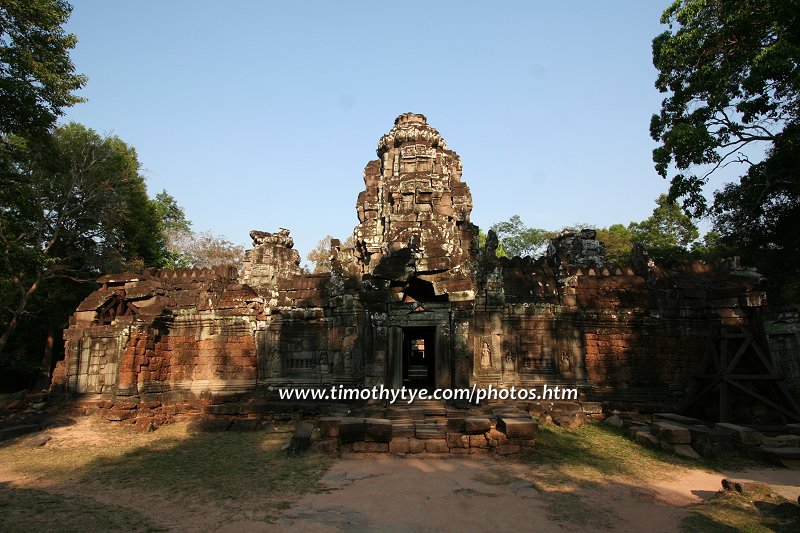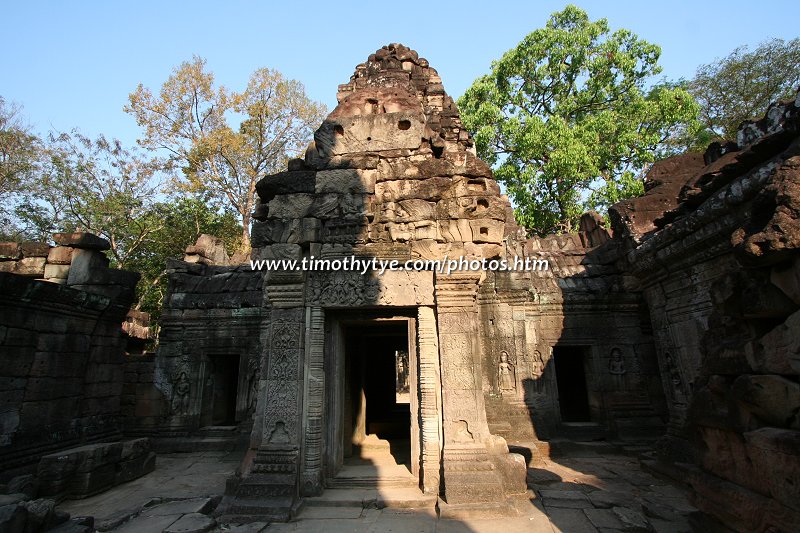 Ta Som (26 February, 2006)
Ta Som (26 February, 2006)
Ta Som (GPS: 13.46367, 103.91349) is a relatively small temple, a sort of mini Ta Prohm. It was built in the late 12th Century by King Jayavarman VII, who reigned from AD 1181 to AD 1220. Indeed the prasats of Ta Som look very much like those at Ta Prohm or Banteay Kdei. Located far away from the rest of the Angkor monuments, Ta Som receives correspondingly fewer visitors compared to the nearer, bigger temples. This, in itself, is good news to those who wish to explore without bumping into other visitors.
360° View of Ta Som on Google Maps Street View
Ta Som is  in the centre of the Map of Angkor
in the centre of the Map of Angkor
I photographed Ta Som towards the end of the day, as I was finishing my exploration of that day. A huge ficus tree wraps itself on the east gopura, a dramatic example of the intertwine of nature and art. Minor restoration is visible during my visit.
Ta Som is located on the eastern side of the East Baray (which is now dry, and hence, it's difficult to make out). It is north of the east-west axis formed Preah Khan and Neak Pean. There was a stele in Preah Khan that mentioned Ta Som, but by its ancient name Gaurasrigajaratna, which means "Jewel of the Propitious White Elephant". As with all Angkor ruins, the name we know it today is a modern name, far different from its original ancient name as found on the stone inscriptions.
 Ta Som (26 February, 2006)
Ta Som (26 February, 2006)
Ta Som consists of three concentric enclosures. It is much simpler in design compared to Ta Prohm, Banteay Kdei and Preah Khan. Ta Som's outermost enclosure wall measures 240 meters by 200 meters. After you have entered the west gopura, you will notice the moat around the second enclosure. The fact that the moat is inside the outer enclosure rather than outside it indicates that the outer enclosure was constructed after the moat was built.
Like Ta Prohm, modern-day visitors approach it from the western entrance, even though its intended main gopura is on the east. Similar to Ta Prohm, Banteay Kdei and Preah Khan, the gopuras of Ta Som also consists of towers with stone faces, but at smaller scale. In fact, the temple of Bayon also has gopuras with face towers - these are the entrances to Angkor Thom. These are the "trademark" of Jayavarman VII.
If you're approaching Ta Som from the east, your first sight would be its East Gopura with a huge strangler fig tree almost enclosing the whole gopura. I read somewhere that the tree died in the 1970s, but I can tell that there still is a tree wrapped over the gopura today, and it's pretty much alive - though, judging from its leave, it's not a fig tree.
I explored Ta Som towards the end of the day, and to a certain extend, had to hurry up before the sun goes down. From Ta Som, I still have one more temple to explore before calling it a day, which is Prasat Batchum.
How to reach Ta Som
Ta Prohm is located on the right side of the road on the way from East Mebon to Neak Pean. If you're coming from East Mebon, follow the road north for 2.5km and look out for it on the right. From Neak Pean, follow the road east for 1.8km before it turns south. The entrance to Ta Som is on your left, a further 300 m down the road. Latest updates on Penang Travel Tips
Latest updates on Penang Travel Tips
 Map of Roads in Penang
Map of Roads in Penang
Looking for information on Penang? Use this Map of Roads in Penang to zoom in on information about Penang, brought to you road by road.
Copyright © 2003-2025 Timothy Tye. All Rights Reserved.

 Go Back
Go Back